
[ Thimphu Festival Tour | Thangbi Mani Festival Tour | Jambay Lhakhang Drup Tsechu Festival Tour | Black Crane Festival Phobjikha Tour | Punakha Domchey Festival Eight Nights Tour | Punakha Domchey Festival Ten Nights Tour | Chorten Kora Tsechu (arrive Paro, Depart Paro) | Chorten Kora Tsechu (arrive Paro, exit India) | Chorten Kora Tsechu (arrive India, exit Paro) | Gom Kora Tsechu (enter Paro, exit Paro) | Gom Kora Tsechu (enter Paro, exit India) | Gom Kora Tsechu (enter India, exit Paro) | Paro Tsechu Festival Tour | Paro Tsechu Festival 7 Dzongkhags Tour | Paro Tsechu Festival Tour with Druk Path Trek | Ura Yakchoe Festival Tour ]
Paro Tshechu & Visit to Thimphu,
Punakha, Wangdue, Phobjikha, Bumthang & Trongsa
- 10 Nights 11 Days
- Western Bhutan
Dzongkhags Visited: Paro, Thimphu, Punakha. Wangduephodrang, Bumthang, Trongsa, PunakhaDuration: 10 Nights 11
Days.
Trip Grade: Easy.
Itinerary Outline:
Day One: Arrive Paro - Thimphu
Day Two: Thimphu to Punakha via Dochula
Day Three: Wangduephodrang Sightseeing:
Day Four: Drive to Bumthang; En route visit Trongsa
Day Five: Bumthang Sightseeing
Day Six: Gangtey and Phobjikha
Day Seven: Punakha to Paro
Day Eight: Paro Tsechu Festival
Day Nine: Paro Festival; afternoon sightseeing
Day Ten: Taktsang Excursion
Day Eleven: Departure
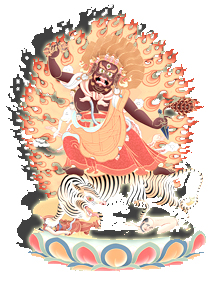 Trip
Overview:
Trip
Overview:
Tsechus or religious festivals are usually the main tourist attractions for visitors. The Thimphu & Paro Festivals account for over 50 per cent of the total arrivals; and certainly Paro Tsechu is the most popular one with its unique unfurling of the world’s biggest Thangka or Thongdrel ceremony. The pageantry is a unique experience and like nothing you may have ever seen before. The festival commemorates deeds of the Great Saint Guru Rinpoche (image on left atop Tigress) which are performed in the form of masked dances. The local folk attend these festivals to build merit. It is also a festive time for the locals who come dressed-up in their finest costumes full of colour to socialise and for merrymaking. This is not an event organised for tourists; it is an event that has been happening for centuries…”You may get the attention of an Atsara (clown), but the people won’t be staring at you like elsewhere”.
Day One: Arrive Paro - Thimphu
During your flight to Paro, you will experience awe-inspiring views of the Himalayan Peaks including sacred Jhomolhari and Jichu Drakey in Bhutan. On arrival at Paro International Airport you will be received by our representative. We head out through the relaxing countryside of terraced rice fields interspersed with rhododendrons and pine forests as we make a relaxed hour’s drive to Thimphu, the tiny capital at 7,600 feet (2316 metres). En route, we see our first examples of Bhutan’s remarkable traditional architecture, one of the country’s unique cultural treasures. Even the most remote village farmhouses are handcrafted using the same ancient methods used to create Bhutan’s religious fortresses called "dzongs". Afternoon, we visit the Tashichhodzong. The ‘Fortress of the Glorious Religion’ houses the Throne Room of His Majesty the (Fifth) King, Jigme Khesar Namgyel Wangchuck, the main Secretariat Building and the Central Monk Body. Its courtyard is open to visitors during the off-office hours- on weekdays after 4 pm (winter), 5pm (summer) and on weekends. Overnight at your Three Star Hotel.
About Thimphu:
Thimphu was a wooded farming valley until 1961, when it became Bhutan's
official national capital (previously it was Punakha). Even today, it
still only has minimal roads and no traffic lights. The massive Tashichhodzong,
about 700 years old, was carefully revamped in the 1960s by the late Third
King Jigme Dorji Wangchuck to house the royal and main government offices.
It is also the summer residence of the Je Khenpo, Bhutan’s Chief
Abbot (equal in rank with the King). Even the most remote village farmhouses
are hand-crafted using the same ancient methods used to create Bhutan’s
religious Dzongs (fortresses). Thimphu is home to the Bhutanese Royal
Family, the Royal Government and to several foreign missions and development
projects. Bhutan’s only golf course, a nine-hole circuit, is situated
next to the magnificent Tashichhodzong. The Third King, Jigme Dorji Wangchuck
was the main architect of modern Bhutan. He died in 1972 and was succeeded
by his son, His Majesty the (Fourth) King, Jigme Singye Wangchuck, who
was 17 years old at the time.
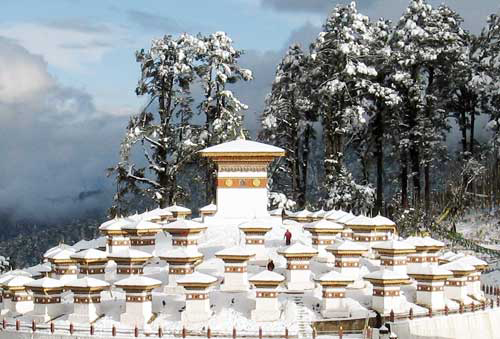 Day
Two: Thimphu to Punakha via Dochula
Day
Two: Thimphu to Punakha via Dochula
Morning sightseeing in Thimphu, we visit the King's Memorial Stupa built in 1974 and tthe Folk Heritage Museum founded by Her Majesty the Queen Mother, Ashi Dorji Wangmo Wangchuck. The museum is one of a kind that portrays the lifestyle of a genteel family in the Thimphu valley in the olden days. Head out of town on a spectacular 3 hrs drive to Punakha crossing the Dochula Pass at 3100 mtrs from where you can see the 108 beautiful Chortens (see right) also built by Her Majesty the Queen Mother, Ashi Dorji Wangmo Wangchuck. From this pass, on a clear day, you can have a superb view of the highest peaks in Bhutan. After a hot lunch at the cafe atop the pass and time to savour the mountain views, we continue our drive to Punakha Valley. Overnight Hotel at Punakha.
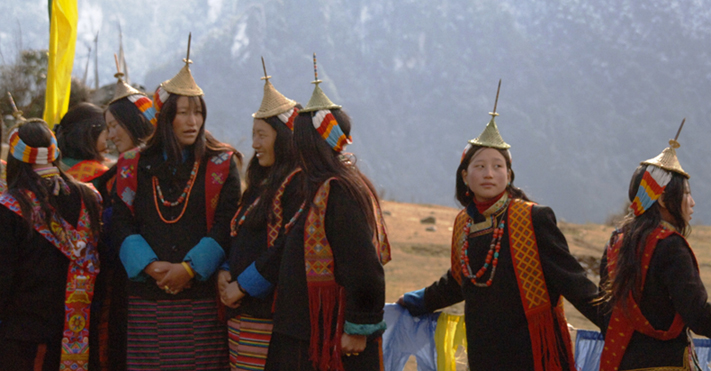
About Punakha: Punakha is located in the low sub-tropical valley about 4100 feet and was the capital of Bhutan until 1955. It is still the winter home of the Chief Abbot, the Je Khenpo, today. The warmer climate in Punakha allows for the production of two rice crops each year, along with oranges, mangos, and bananas. In Punakha, we may see people from the remote village of Laya. The Layaps, as they are known, are yak herders who make the three or four-day walk to Punakha from their high-altitude villages in northwest Bhutan. Women of Laya (see above- These Layaps had just returned from pilgrimage to Dorji Den or Bodhgaya) wear conical bamboo hats with a centre spike of bamboo, and Laya’s men wear black woolen coats.
Day Three: Wangduephodrang Sightseeing:
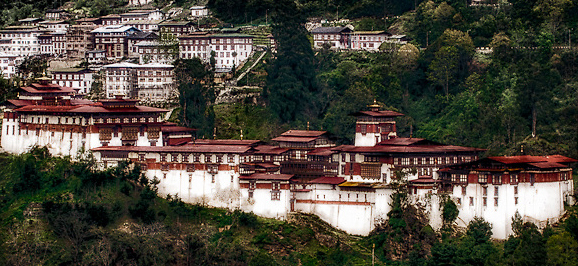 A half-hour walk through mustard fields brings us to Chimmi Lhakhang ('Lhakhang'
means temple), a monastery and fertility temple dedicated to Lama Drukpa
Kuenley, a Tibetan Buddhist Saint known popularly as ‘the Divine
Madman’ and considered a folk hero in Bhutan for his unconventional
ways. Drukpa Kuenley originally built a Chorten on the site in the 14th
century. The temple, flanked by nearly 100 tall prayer flags, sits atop
a picturesque hill and has long been a pilgrimage site for childless couples.
Also, drive to Wangduephodrang and visit the ruins of the beautiful Wangduephodrang
Dzong. Built in 1638, it was a beautiful example of Bhutanese architecture
(above). Sadly, the Dzong was razed by fire in 2012 and funds to renovate
have been raised from both Bhutanese and visitors. Above picture is of
Wangdue Dzong before the fire. Overnight at Hotel.
A half-hour walk through mustard fields brings us to Chimmi Lhakhang ('Lhakhang'
means temple), a monastery and fertility temple dedicated to Lama Drukpa
Kuenley, a Tibetan Buddhist Saint known popularly as ‘the Divine
Madman’ and considered a folk hero in Bhutan for his unconventional
ways. Drukpa Kuenley originally built a Chorten on the site in the 14th
century. The temple, flanked by nearly 100 tall prayer flags, sits atop
a picturesque hill and has long been a pilgrimage site for childless couples.
Also, drive to Wangduephodrang and visit the ruins of the beautiful Wangduephodrang
Dzong. Built in 1638, it was a beautiful example of Bhutanese architecture
(above). Sadly, the Dzong was razed by fire in 2012 and funds to renovate
have been raised from both Bhutanese and visitors. Above picture is of
Wangdue Dzong before the fire. Overnight at Hotel.
Day Four: Drive to Bumthang; Enroute visit Trongsa
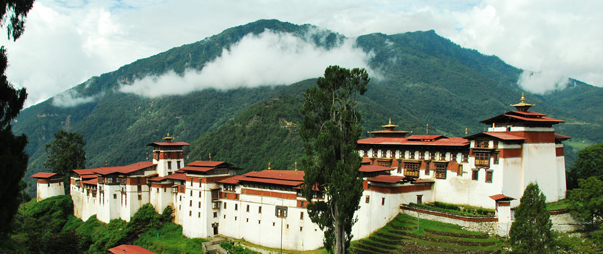 We drive to Bumthang via Trongsa crossing the Pelela pass (altitude
3,300 metres above sea level), the traditional boundary between east and
west Bhutan. The pass is marked by a large prayer flag and the ground
is covered with high altitude dwarf bamboos. Stop enroute at Chendbji
Chorten, which was built in the 18th century by a lama named Shida- it
is Nepalese in style with eyes painted at four cardinal points. Having
a central location in Bhutan, Trongsa is often referred to as the Gateway
to the East. Sloping down the contour of a ridge stands the many-leveled
Trongsa Dzong (above right), built in 1648. It is the
largest Dzong in Bhutan and has a very strategic position. The view from
the Dzong extends for miles, and all west-east traffic have to pass by
it. The Kings of Bhutan usually become Trongsa Penlops (Governor of Trongsa
District) before they are King. Drive on to Bumthang where we spend the
night which is about a 2 hours drive.
We drive to Bumthang via Trongsa crossing the Pelela pass (altitude
3,300 metres above sea level), the traditional boundary between east and
west Bhutan. The pass is marked by a large prayer flag and the ground
is covered with high altitude dwarf bamboos. Stop enroute at Chendbji
Chorten, which was built in the 18th century by a lama named Shida- it
is Nepalese in style with eyes painted at four cardinal points. Having
a central location in Bhutan, Trongsa is often referred to as the Gateway
to the East. Sloping down the contour of a ridge stands the many-leveled
Trongsa Dzong (above right), built in 1648. It is the
largest Dzong in Bhutan and has a very strategic position. The view from
the Dzong extends for miles, and all west-east traffic have to pass by
it. The Kings of Bhutan usually become Trongsa Penlops (Governor of Trongsa
District) before they are King. Drive on to Bumthang where we spend the
night which is about a 2 hours drive.
Day Five: Bumthang Sightseeing
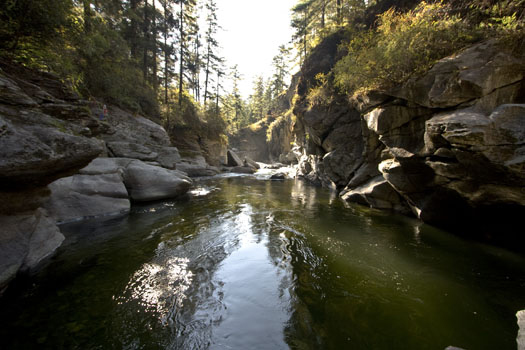 Bumthang
valley is one of the most sacred places in the Kingdom and innumerable
legends surround the area. It is here that the Kings are cremated and
the present royal family traces their ancestry back to the famous saint,
Pemalingpa. Full day sightseeing include visit to Kurjey Lhakhang (where
the Saint Padmasambhava subdued a local demon and left his body imprint
on a rock), Jambay Lhakhang which was built in the 7th century, then Jakar
Dzong (the Fortress of the White Bird) built in the 17th century by Tenzin
Rabgay (the fourth Desi), Tamshing Lhakhang built in 1501 by Terton Pema
Lingpa (the founder of religious treasures). Then visit Kenchosum Lhakhang
and Membartsho (the Burning Lake seen above)-in fact
it is a gorge where the river runs through but legend runs that Pema Lingpa
discovered religious texts from this lake. Also worth seeing are the woodcraft
workshop, Traditional hospital, and the cheese factory. Overnight in Bumthang.
Bumthang
valley is one of the most sacred places in the Kingdom and innumerable
legends surround the area. It is here that the Kings are cremated and
the present royal family traces their ancestry back to the famous saint,
Pemalingpa. Full day sightseeing include visit to Kurjey Lhakhang (where
the Saint Padmasambhava subdued a local demon and left his body imprint
on a rock), Jambay Lhakhang which was built in the 7th century, then Jakar
Dzong (the Fortress of the White Bird) built in the 17th century by Tenzin
Rabgay (the fourth Desi), Tamshing Lhakhang built in 1501 by Terton Pema
Lingpa (the founder of religious treasures). Then visit Kenchosum Lhakhang
and Membartsho (the Burning Lake seen above)-in fact
it is a gorge where the river runs through but legend runs that Pema Lingpa
discovered religious texts from this lake. Also worth seeing are the woodcraft
workshop, Traditional hospital, and the cheese factory. Overnight in Bumthang.
Day Six: Gangtey and Phobjikha
After breakfast proceed to Gangtey and Phobjikha. The approach to Phobjikha valley is through a forest of Oak and Rhododendron. It is a glacial valley on the western slopes of the Black Mountains. The only Nyingmapa (a sect of Buddhism) monastery, Gangtey Goemba sits prominently on a hill top. The valley is a designated conservation area and borders on the Black Mountain National Park. Because of the large flock of black-necked cranes (Grus nigricollis) that migrate here in the winter, it is one of the most important wildlife preserves in the country. The Royal Society for the Protection of Nature (RSPN)’s Crane Observation & Education Centre was established in the Phobjikha Valley in 1996 by Bhutan’s government, with assistance from the World Wildlife Fund. The Centre studies the conservation needs of the valley and holds workshops for farmers and students. Here you can use the Centre’s powerful binoculars to observe the cranes in the valley and also get information about the cranes. The rare and endangered black-necked crane occupies a special place in Bhutanese hearts and folklore. Its arrival every autumn from Tibet inspires songs and dances; it usually heralds the end of the harvesting season and signals the villagers that the time has come to pack up and go to the warmer lower valleys since Phobjikha valley is snowed-in during the winter months. The world’s entire population of about 5000 black-necked cranes breed in Tibet and Ladakh. They winter in south-central Tibet and Bhutan. Overnight Hotel at Punakha.
Day Seven: Punakha to Paro
Morning drive to Paro via Dochula. After a hot cup of coffee at a cafe atop, we continue our drive to Paro. Visit Tag Dzong, built in the 17th century as a watch tower for Paro Dzong. This Dzong was later converted into the National Museum in 1967 and is filled with antique thangkha paintings, textiles, weapons and armour. Also visit the Rinpung Dzong, built in the 17th century to defend the valley against Tibetan invaders. It is now used as an administrative centre and home of the monastic community. Kyichu Lhakhang, the oldest monastery in the Kingdom is another place of interest. Overnight at Hotel in Paro.
Day Eight: Paro Tsechu Festival
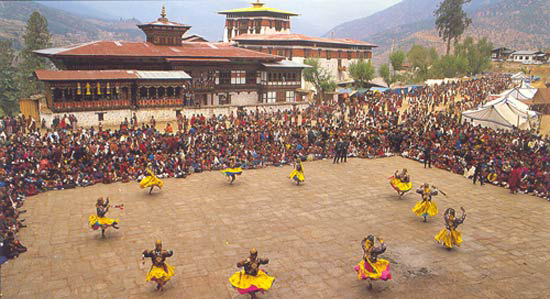 Full
day at the Paro Tshechu festival (see right). Each spring,
the usually-quiet town of Paro comes alive with the annual Buddhist celebration
of Tsechu.
Full
day at the Paro Tshechu festival (see right). Each spring,
the usually-quiet town of Paro comes alive with the annual Buddhist celebration
of Tsechu.
Day Nine: Paro Festival; afternoon sightseeing
The five-day-long festival climaxes early in the morning of the fifth day as the great thangkha is unveiled, just one night ahead of the month’s full moon. Thousands of Bhutanese from around the country travel to Paro Dzong to view the large silk tapestry and cleanse themselves of sin. But as usual, with Tsechus, there are also many hours of music and colourful cham dances. These Buddhist performances are enjoyed by children and adults alike, who crowd up the hillsides surrounding the Dzong. Overnight at Hotel.
Day Ten: Taktsang Excursion
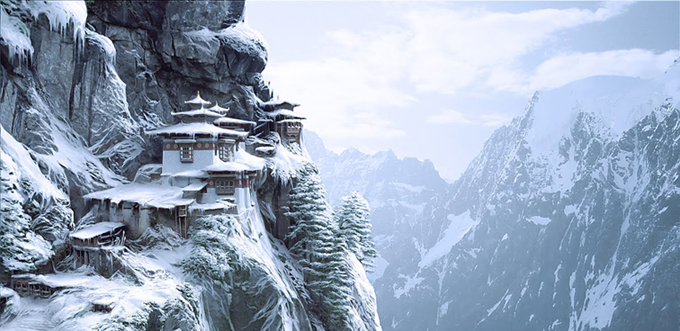
Hike to the famous Taktsang Lhakhang (above under snow) also known as the Tiger's Lair. Clinging to a black rock face, 900 metres above the valley floor, nestles Taktsang Lhakhang, one of the holiest and most beautiful sites of Bhutan. Taktsang, the Tiger's Lair, acquires its name from the legend of its foundation, when in the 8th Century, Guru Rinpoche, widely revered as the second Buddha, arrived from Tibet flying across the mountains on the back of a tigress. He meditated at the site for three months, from where he used the religious cycle of the Kagye to subjugate the Eight Categories of Evil Spirits, and thus converted the region to Buddhism. The hike to the Monastery is a gradual climb through the quiet approach path winds through lush meadows, oak and rhododendron forest, past quaint hamlets, fluttering prayer flags and rotating prayer wheels. The hike takes you about 4-5 hours from the car park. Afternoon leisure/shopping. Overnight at your Hotel.
Day Eleven: Departure
Our representative will bid you farewell and see you again.
As festival times are the most popular times for visitors to come to Bhutan, flight seats and hotel rooms will be on high demand. Book early to avoid disappointment.
| |
BACK TO FESTIVAL TOURS MAIN PAGE |
